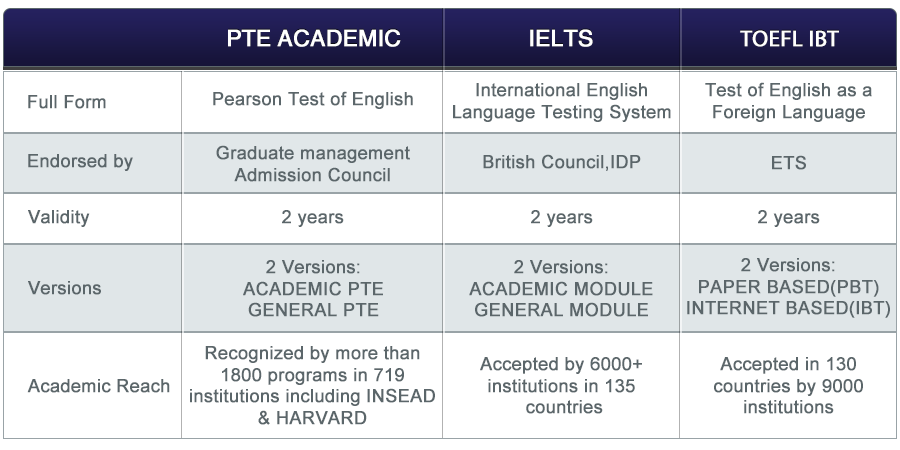

For non-native English speakers, the IELTS, PTE, and TOEFL exams are the most extensively used and accepted language competency assessments.
Furthermore, these exams are widely recognized by educational institutions, government agencies, immigration offices, and other private organizations worldwide. Moreover, these exams provide high-quality and dependable language assessments of a person's English language abilities.
These language tests evaluate basic English language skills such as writing, speaking, reading, and listening. These exams are also standardized, with specified frameworks and scoring systems.
Many test-takers, including yourself, are undecided about which language exam to take. As a result, to make your life easier, we'll compare these tests so you can decide which one to take.
Please continue reading to learn about the distinctions between different language exams, how they differ, and whether they have any commonalities and other exam characteristics. This article will assist you in selecting the appropriate language exam for you.

The International English Language Testing System, or IELTS, is an English language assessment test widely acknowledged and recognized by prestigious universities and colleges around the world.
The British Council developed this standardized language test to evaluate several English language skills, such as writing, speaking, listening and reading.
Furthermore, significant multinational organizations like this exam are widely utilized for job applications. Government and immigration departments in most English-speaking countries worldwide recognize it as well.
Test takers can choose between two exam formats: the IELTS Academic and the IELTS General Training Test. And the substance of these two test formats differs, particularly in the writing and reading test sections and their purposes.
It also accepts both British and American English phrases, and its speaking test component includes a variety of English dialects. You can, however, take this exam on paper or on a computer, whichever is more convenient for you.
Furthermore, the IELTS exam provides non-native English speakers with a dependable and accurate English language competency certification.
For non-native English speakers, the TOEFL exam is a standardized English language competence exam. This exam, commonly known as the Test of English as a Foreign Language, is widely recognized and accepted by most academic institutions worldwide.
Furthermore, the TOEFL exam is used for academic admissions, including exchange programs and other college and university courses.
In addition, if you plan to apply to international firms both here and overseas, the TOEFL language competence certification can be used for student visa applications and employment requirements.
The TOEFL exam is available in two formats: TOEFL iBT and TOEFL PBT. Furthermore, most test-takers prefer the TOEFL iBT to the TOEFL PBT.
Note that the TOEFL PBT does not assess speaking ability; however, it does have another test portion, Structure and Written Expression, that evaluates a person's grammar abilities. These TOEFL formats each have four test components, with the TOEFL iBT including a section on speaking.
Furthermore, this exam is designed to evaluate all four aspects of English language communication: reading, listening, speaking, and writing.
One of the most distinguishing elements of the PTE, or Pearson Test of English Academic Test, is a computer-based English language proficiency test. Furthermore, the grading system for this exam incorporates AI technology.
Furthermore, most PTE exam-takers favor the PTE because it provides speedy test results within 48 hours. Moreover, this language competence exam is available in more than 70 countries worldwide.
Depending on your needs and goals for taking the exam, you can choose from three types of PTE exams, including the PTE Academic, PTE General, and PTE Young Learner Test.
Additionally, this exam can be taken by anyone of any age group because there are no age restrictions.
Furthermore, the PTE is designed to examine real-life English language abilities, so the examination focuses on how the individual communicates in English. It has four portions that assess listening, reading, speaking, and writing abilities.
Many educational institutions, visa applications, and industrial enterprises accept and use this language competency test to assess the language proficiency of their candidates and staff.

The reading, writing, listening, and speaking skills are assessed on these three language competence exams. However, the exam structure, duration, mode of delivery, and other exam elements vary significantly.
In addition, the test parts for the IELTS, PTE, and TOEFL exams differ.
For example, the IELTS Academic and General Training Tests each have their test portions.
In addition, while comparing these three language examinations, the PTE is the only one that offers just a computer-based version of the test and does not offer a paper-test version.
As a result, the IELTS and TOEFL offer both paper-based and computer-based language exams. The duration of these three language tests is also relatively comparable, lasting between two and four hours at most.
If you want to learn more about the differences between these three language examinations, look at the table below for more information on their exam procedures.
|
Exam Structure |
IELTS |
TOEFL |
PTE |
|
Test Sections |
1. Listening 2. Writing 3. Reading 4. Speaking |
TOEFL PBT Test Sections: 1. Listening Structure and Written Expression 2. Reading 3. Writing TOEFL iBT Test Sections: 1. Reading 2. Listening 3. Speaking 4. Writing |
1. Listening 2. Writing 3. Reading 4. Speaking |
|
Test Versions/ Types |
1. IELTS Academic 2. IELTS General Training |
Not available |
1. PTE Academic 2. PTE General 3. PTE Young Learner |
|
Test mode of Delivery |
1. Paper-based IELTS Test 2. Computer-based IELTS |
1. TOEFL PBT (Paper-based Test) 2. TOEFL iBT (Internet-based Test) |
Computer-based test only |
|
Test Duration |
2 hours and 45 minutes |
3 to 4 Hours with additional 30 minutes check-in period |
3 Hours |
The scoring systems for the IELTS, PTE and TOEFL exams differ. The PTE's computerized scoring system employs an automatic scoring algorithm for starters. It's likewise based on a global score system, and the CEFR levels can be used to interpret it.
Furthermore, the PTE Academic uses an overall scoring system for its exam parts, ranging from 90 points for the highest to 10 points for the lowest. Again, the whole sum and average of your overall test scores, enabling skills test scores, and communication skills test scores make up your PTE overall score.
Grammar, oral fluency, pronunciation, spelling, vocabulary, and written discourse English language abilities are among the enabling talents. Listening, writing, speaking, and reading skills are all included in the communication skills category.
On the other hand, the TOEFL uses a centralized scoring network for its exam. It also uses a 120-to-31-point scoring system. The centralized scoring network in the computer also scores the Reading and Listening test portions.
In addition, automatic AI scoring and highly-trained professional TOEFL test raters are used to score the writing and speaking components of the test.
Furthermore, the IELTS test scores its portions using a banding system. The score runs from 9 to 0, with nine being the highest and 0 being the lowest possible score.
It's worth noting that the scoring systems and points for these three language proficiency exams differ. However, it has no bearing on the accuracy and reliability of its language proficiency evaluation. Furthermore, the results of these exams are valid for two years.
|
IELTS Exam Band Scoring |
TOEFL Overall Score Conversion |
PTE Scoring |
|
9 |
118 to 120 |
85 to 90 |
|
8.5 |
115 to 117 |
76 to 84 |
|
8 |
110 to 114 |
59 to 75 |
|
7.5 |
102 to 109 |
43 to 58 |
|
7 |
94 to 101 |
30 to 42 |
|
6.5 |
79 to 93 |
10 to 29 |
|
6 |
60 to 78 |
|
|
5.5 |
46 to 59 |
|
|
5 |
35 to 45 |
|
|
4.5 |
32 to 34 |
|
|
0 |
0 to 31 |
The PTE is one of the most popular computer-based English language competency exams. The IELTS and TOEFL are two more well-known English language competency exams.
Most universities and colleges in various nations worldwide recognize and accept these three exams. They are also utilized to deliver a dependable and accurate language proficiency certification by multinational industrial enterprises, government organizations, and other private sectors.
In addition, the PTE Test is recognized in over 70 countries and is used by over 3,000 educational institutions throughout the world. Furthermore, with over 1,200 official testing sites in various places, the IELTS exam is extensively utilized and trusted by over 140 nations worldwide.
Furthermore, the TOEFL exam is accepted by more than 10,000 educational institutions in 150 countries worldwide, and it has a 100% acceptance record at UK universities. As a result, you can rest assured that you will get admitted into these prestigious institutions and universities.
Most English-speaking countries, including Canada, the United States, the United Kingdom, Australia, France, Germany, the United Arab Emirates, and others, recognize these language exams. As a result, government agencies and immigration offices accept the IELTS and TOEFL exams.